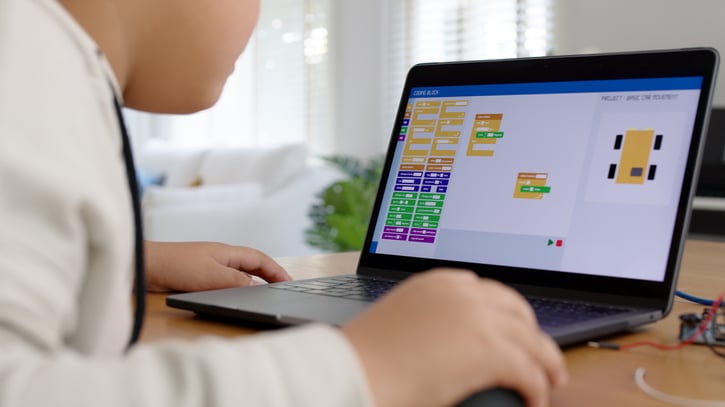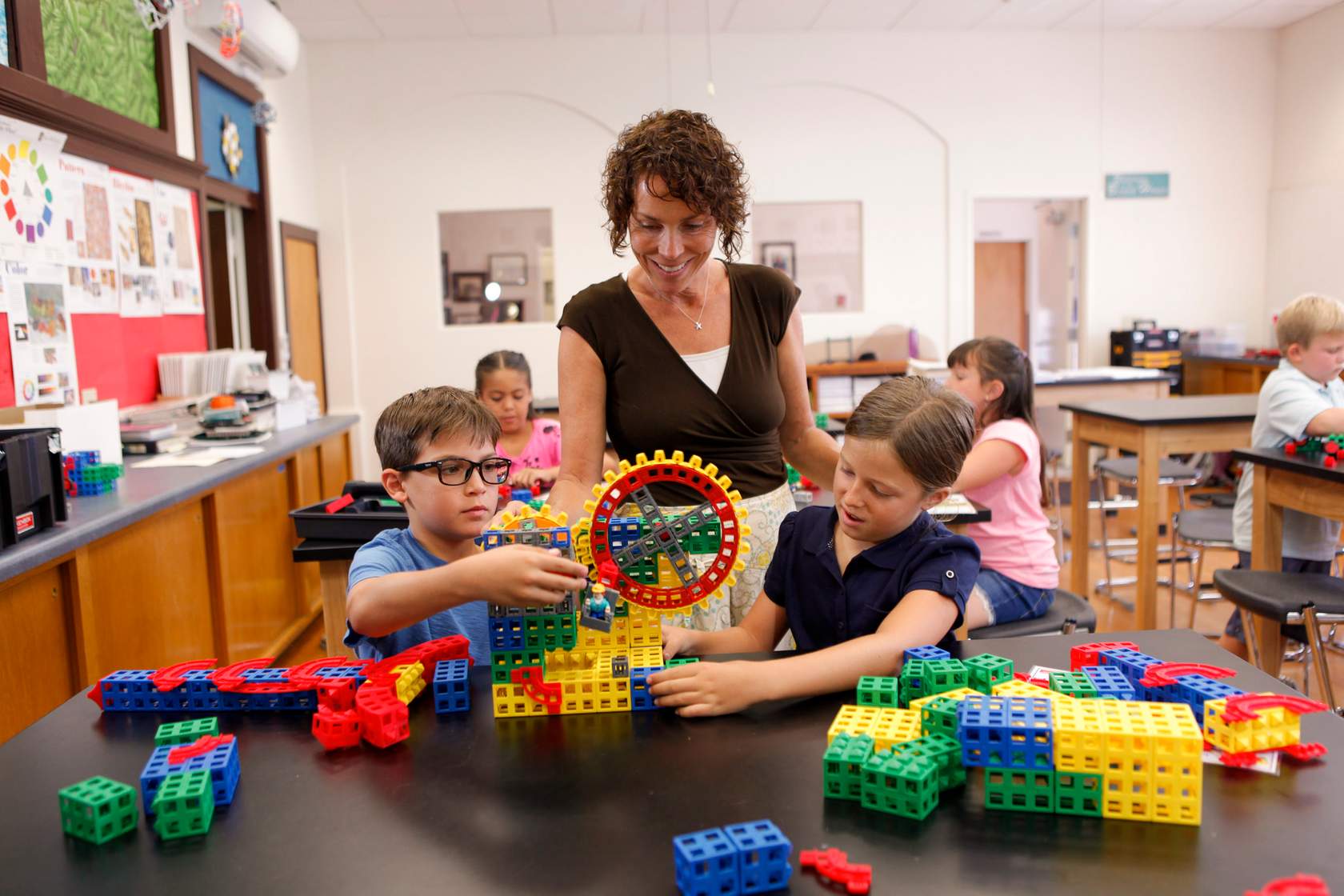
For students in Kindergarten through the 8th grade, getting STEM education early and consistently throughout their education is deeply important. That’s why, at Kid Spark Education we’re happy to offer STEM Labs for students in PreK-8. We want to help foster a love of problem solving and scientific thinking that can support students throughout their lives. Because STEM is such an integrated and interdisciplinary approach to learning, it engages kids in meaningful and collaborative work that mirrors real life.
We do this with our two STEM labs: Foundational Fluencies and STEM Pathways. These labs include age-appropriate building blocks and robotic materials that inspire collaborative learning and, as always, a lifelong love of design and engineering thinking. Having the opportunity to learn hands-on and in the classroom provides the tools needed for students to grow throughout their lives, whether they pursue STEM as a career or not.
Still not convinced STEM labs are needed in your classroom? Here are 5 reasons STEM education makes a lasting impact:
1. STEM Education Aids Child Development
From a child development perspective, the years between PreKindergarten and 8th grade are crucial. As the University of Nevada reports, “In addition to developing an interest and knowledge base for STEM and enhanced inquiry skills, experts say that science instruction improves abilities in subjects outside of STEM, including literacy, language-learning, math, and executive functioning”. Programs like Kid Spark Education can help this age demographic succeed in a technologically-driven world and utilize the skill sets in all areas of their lives, while encouraging problem-solving, collaborative thinking, and experimentation.
By solving problems in our STEM labs, students are able to become active participants in their own learning and to understand how and why things work, as well as design solutions to improve our everyday lives.
2. Teach Lifelong Skills in Cooperation and Collaboration
The ability to collaborate and communicate is a skill that all students will use their entire lives. Whether they end up in a career in STEM or not, being able to work together to solve problems will only help the students grow. Interactive teamwork and specific roles for each participant help students learn the fundamentals of working within a group structure.
Our STEM Labs and combined curriculum teach PreK-8 students to develop these skills because it’s a place where students cooperate in order to engage problems, to build on team member’s ideas, and to find solutions to complex problems. While working in teams and learning about collaboration, students strengthen their ability to effectively communicate and problem-solve. To work within a team, students must express ideas with one another and consider differing viewpoints appropriately. By teaching students these skills and introducing them to technology in the process, students will be prepared to work with each other in the modern world.
3. Prepare Students for Bright Futures
Imagine if you had been inspired by and dedicated to your chosen profession at an early age. By offering labs introducing a variety of STEM concepts, including introducing coding with Microsoft’s MakeCode programming environment, students can learn what they are truly passionate about and what they enjoy building. With this foundation, they can explore those skills deeper throughout their educational lives. Leveraging Kid Spark Education’s STEM Labs can act as a catalyst for not only lifelong learning and critical thinking skills, but also as the foundational building blocks of a professional career and intellectual pursuits into adulthood.
Beyond that, STEM concepts are an essential tool for understanding and interacting with the world. Students who are “STEM fluent” learn to think critically, solve creatively, and engage fearlessly with the world around them. By providing tools to support STEM education, from toddler to teen to teacher, Kid Spark Education helps students develop the courage to imagine a better world and the skills to create it. Learning those creative skills creates an even brighter future.

4. Teach Critical Technology Literacy Skills
In the wake of COVID-19, organizations across industry are depending on more technology and apps to stay connected and do work. The use of cloud technology, collaboration apps, and other digital solutions has risen exponentially in the past couple years, with many students often using these tools in online learning. As students grow up, our world is likely only going to use more and more advanced technology. That means students need to learn a familiarity with engineering, science, math, and technology in order to succeed throughout their lives.
Our STEM labs and combined curricuum teach students to think critically with technology like coding, 3D printing, robotics and more. Students become more aware of technology's power in today's society and how it can be applied to their careers.
5. Give Students the Chance to Experiment and Grow
Students using our STEM labs experiment with various projects and take necessary risks during the learning process. By cooperating and building solutions together, they are able to test their theories and ideas without fear of failure. This not only allows them to get key learning outcomes effectively but also encourages more creative critical thinking.
This experimentation is actually a key part of child development. Through play, children experiment and try out ideas to learn all about the world, while developing fine motor skills and reaching learning outcomes. According to the American Academy of Pediatrics:
“Play allows children to use their creativity while developing their imagination, dexterity, and physical, cognitive, and emotional strength. Play is important to healthy brain development. It is through play that children at a very early age engage and interact in the world around them. Play allows children to create and explore a world they can master, conquering their fears while practicing adult roles, sometimes in conjunction with other children or adult caregivers. As they master their world, play helps children develop new competencies that lead to enhanced confidence and the resiliency they will need to face future challenges”

Kid Spark Education’s STEM labs combine that possibility for play with necessary curriculum about STEM concepts, so that students PreK-8 can grow from that experimentation and learning year after year. This provides an environment where students can experiment with new ideas and to learn from mistakes without fear of judgment. Whether it’s the creation of simple machines or reconfiguring a series of building blocks, students that go hands-on using the STEM Labs have the opportunity to conceptualize, test, and experiment with new and imaginative ideas.
Ready to Add PreK-8 STEM Labs at Your School?
Of course, this is just a quick overview of the key benefits of PreK-8 STEM Labs. If you’re interested in learning more about adding Kid Spark Education programs at your school, we’d be happy to talk to you about this further.
With Kid Spark, students learn to see like designers and think like engineers, so that they have the skills to change the world. Ultimately these experiences help students develop a lasting interest in STEM for years to come. Learn all about our Elementary and Middle School STEM programming here. If you would like to bring Kid Spark Education to your classroom, purchase programs here.
.png?width=1270&height=453&name=Copy%20of%20Kid%20Spark%20Logo%20(Horizontal%20-%20Full%20Color).png)